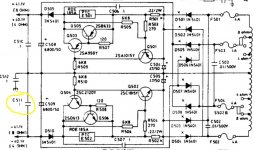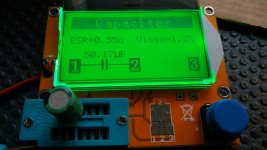Hi All,
I recently acquired a faulty NAD 7225PE. It's a nice little unit and sounds great. But one channel was cutting in/out/crackling etc.
I tracked it down to this little 100nF 100V CAP, which exploded and left little pieces of ceramic and metal everywhere! It's a cap on the +/- 40 volt rail.
Now... what can I change it with? 100V ceramics are hard to come by, even after a quick search of e14/mouser/ebay/aliexpress. However, there are heaps of cheap 100nF 1KV caps around. Can I use them, will it affect anything? They just don't look ceramic, with their blue covering.
I recently acquired a faulty NAD 7225PE. It's a nice little unit and sounds great. But one channel was cutting in/out/crackling etc.
I tracked it down to this little 100nF 100V CAP, which exploded and left little pieces of ceramic and metal everywhere! It's a cap on the +/- 40 volt rail.
Now... what can I change it with? 100V ceramics are hard to come by, even after a quick search of e14/mouser/ebay/aliexpress. However, there are heaps of cheap 100nF 1KV caps around. Can I use them, will it affect anything? They just don't look ceramic, with their blue covering.
Attachments
The blue 1kV capacitor should be fine. Below is a suitable Mouser part number, $0.14US each.
75-1C25X7R104K100B Multilayer Ceramic Capacitors MLCC - Leaded 100000pF 100V X7R 10% 6.4mm LS
75-1C25X7R104K100B Multilayer Ceramic Capacitors MLCC - Leaded 100000pF 100V X7R 10% 6.4mm LS
To be certain of what this cap is supposed to be doing, a reference to the schematic or part number might be useful: NAD 7225PE - Manual - AM/FM Stereo Receiver - HiFi Engine
Thanks for the advice. I guess the main question really was: Will a different type: multilayer, film etc make the amp sound different?
In the mean time I put in a 50v I already had on hand and it sounds great 😀 Though, I suppose it will get a bit stressed over time.
In the mean time I put in a 50v I already had on hand and it sounds great 😀 Though, I suppose it will get a bit stressed over time.
Attachments
It'll work fine with any cap of a similar value and same or higher voltage rating that you have to hand - anything from 100n up, film, ceramic, multilayer, disk, whatever is to hand.
Importantly though, you need to ensure that there's nothing left there that caused it to blow - IME ceramic caps are incredibly reliable, and they usually only fail if something causes them to. I'd be checking the rails for excessive AC ripple and replacing the electrolytics on the rail.
I recently did a recap on my 3020B and it made a _huge_ difference to the amp - much quieter now.
Importantly though, you need to ensure that there's nothing left there that caused it to blow - IME ceramic caps are incredibly reliable, and they usually only fail if something causes them to. I'd be checking the rails for excessive AC ripple and replacing the electrolytics on the rail.
I recently did a recap on my 3020B and it made a _huge_ difference to the amp - much quieter now.
Last edited:
It'll work fine with any cap of a similar value and same or higher voltage rating that you have to hand - anything from 100n up, film, ceramic, multilayer, disk, whatever is to hand.
Importantly though, you need to ensure that there's nothing left there that caused it to blow - IME ceramic caps are incredibly reliable, and they usually only fail if something causes them to. I'd be checking the rails for excessive AC ripple and replacing the electrolytics on the rail.
I recently did a recap on my 3020B and it made a _huge_ difference to the amp - much quieter now.
I think it blew because it was physically pressed up against the 3A (1N5401) diode, while its partner on the other channel had an air gap. But interesting what you say about the electrolytics, I suppose the 3020B is a similar circuit. I don't have an ESR meter, but have a scope. The best I can do is measure ripple on the 41.1V rails. But what's a good/bad value and at what volume?
Anything more than a couple of hundred millivolts at idle will be a problem. Looking at the schematic, C504 & C505 will really cop a hiding, with lots of ripple current. I’d be expecting them to be dead.
On my 3020 the main filter caps were fine - it was all the smaller electrolytics that had problems. They’re all 20c parts, so I just replaced the whole lot.
On my 3020 the main filter caps were fine - it was all the smaller electrolytics that had problems. They’re all 20c parts, so I just replaced the whole lot.
C504 & C505 actually seem to be alive. Sure, this LCR meter is a bit of a toy, but I guess they're serviceable.
I also found a weird bodge where somebody soldered a 1N4148 on the bottom side of the PCB - what the hell is that.
Occasionally I'm still getting a crackle in one channel. I think it might be the FM button contacts that are dirty or corroded.
I also found a weird bodge where somebody soldered a 1N4148 on the bottom side of the PCB - what the hell is that.
Occasionally I'm still getting a crackle in one channel. I think it might be the FM button contacts that are dirty or corroded.
Attachments
- Status
- Not open for further replies.
- Home
- Amplifiers
- Solid State
- Help me repair a NAD 7225PE



